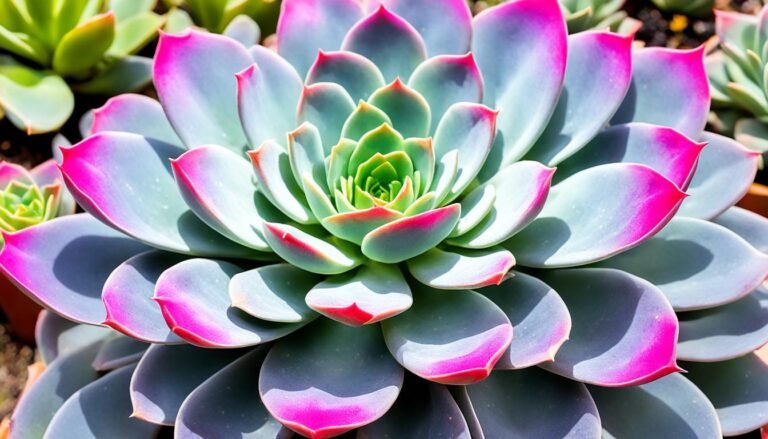Indoor gardening has always been a source of joy and relaxation for me. There’s something so fulfilling about nurturing plants and watching them thrive. And when it comes to succulents, one variety that has captured my heart is the Echeveria Persia. Its intricate foliage and vibrant colors make it a stunning addition to any indoor garden.
Let me tell you a little story about how I discovered the beauty of the Echeveria Persia. A few years ago, I was on a trip to a botanical garden with a friend. As we explored the different sections, we stumbled upon a greenhouse filled with succulents. The mesmerizing patterns and unique shapes of the Echeveria varieties caught my attention, but it was the Echeveria Persia that truly captivated me.
I couldn’t take my eyes off its rosette form, with each leaf delicately outlined in shades of green and purple. It looked like a living work of art. I was instantly drawn to its charm and knew I had to bring one home.
However, I soon realized that caring for the Echeveria Persia required specific knowledge and attention. Its unique needs and preferences called for a plant care guide tailored specifically to this stunning succulent. I quickly embarked on a journey to learn everything I could about growing and nurturing the Echeveria Persia, and now I’m excited to share my knowledge with you.
In this comprehensive plant care guide, you will find essential tips on watering, light requirements, nutrient needs, propagation techniques, and more. Whether you’re a beginner or an experienced indoor gardener, these care tips will help you master the art of keeping your Echeveria Persia healthy and vibrant.
Key Takeaways:
- Echeveria Persia is a stunning variety of succulent with vibrant colors and intricate foliage.
- Proper care and attention are essential for the health and beauty of your Echeveria Persia.
- This comprehensive plant care guide will provide you with valuable tips on watering, light requirements, nutrient needs, propagation techniques, and more.
- Mastering the art of indoor gardening with the Echeveria Persia will bring you joy and satisfaction.
- Stay tuned to learn how to care for your Echeveria Persia and watch it thrive in your home.
Watering Echeveria Persia
Proper watering is crucial for the health of your Echeveria Persia, a stunning succulent plant that is popular in indoor gardening. As an echeveria variety, the Echeveria Persia requires specific care to maintain vibrant foliage. Succulent plants, including Echeveria Persia, thrive in dry soil and have unique watering needs compared to other houseplants.
When it comes to watering your Echeveria Persia, less is more. Overwatering can lead to root rot and other issues, so it’s important to practice restraint. I recommend watering your Echeveria Persia every 12 days, allowing the soil to dry out between waterings. This watering frequency helps mimic the plant’s natural habitat and prevents moisture-related problems.
One way to determine if your Echeveria Persia needs watering is by checking the soil moisture level. Insert your finger about an inch into the soil. If it feels dry, it’s time to water your succulent. However, if the soil feels moist, it’s best to hold off on watering until it dries out.
Additionally, it’s essential to use well-draining soil for your Echeveria Persia. This succulent thrives in soil that doesn’t retain too much moisture. A mixture of potting soil, perlite, and sand can create an optimal growing medium that allows excess water to drain away efficiently.
Water Calculator for Personalized Watering Recommendations
To help you determine the ideal watering schedule for your Echeveria Persia, I recommend using our water calculator. This tool takes into account various factors such as your environment and pot size to provide customized recommendations. Simply input the necessary information, and the water calculator will guide you in watering your succulent effectively.
Remember, when it comes to watering Echeveria Persia, it’s better to underwater than to overwater. This succulent plant has adapted to arid conditions and is well-suited to dry soil. By following these watering tips and using the water calculator, you’ll be able to provide the right amount of hydration for your Echeveria Persia, ensuring its health and beauty.
“Proper watering is crucial for the health of your Echeveria Persia.”
| Watering Frequency | Soil Moisture Level |
|---|---|
| Every 12 days | Dry soil, about an inch deep |
Light Requirements for Echeveria Persia
Echeveria Persia, a stunning succulent plant, thrives in abundant bright and direct light. To ensure its growth potential, place your Echeveria Persia less than 1 foot away from a south-facing window. This allows the succulent to receive the maximum amount of sunlight it requires. It is important to note that Echeveria Persia does not tolerate low-light conditions well, so providing adequate sunlight is essential for its health and vibrancy.
When considering the placement of your Echeveria Persia in your home, it is recommended to select your region and understand how the current weather conditions may affect its light requirements. By taking this into account, you can make informed decisions about where to position your succulent to optimize its exposure to natural light.
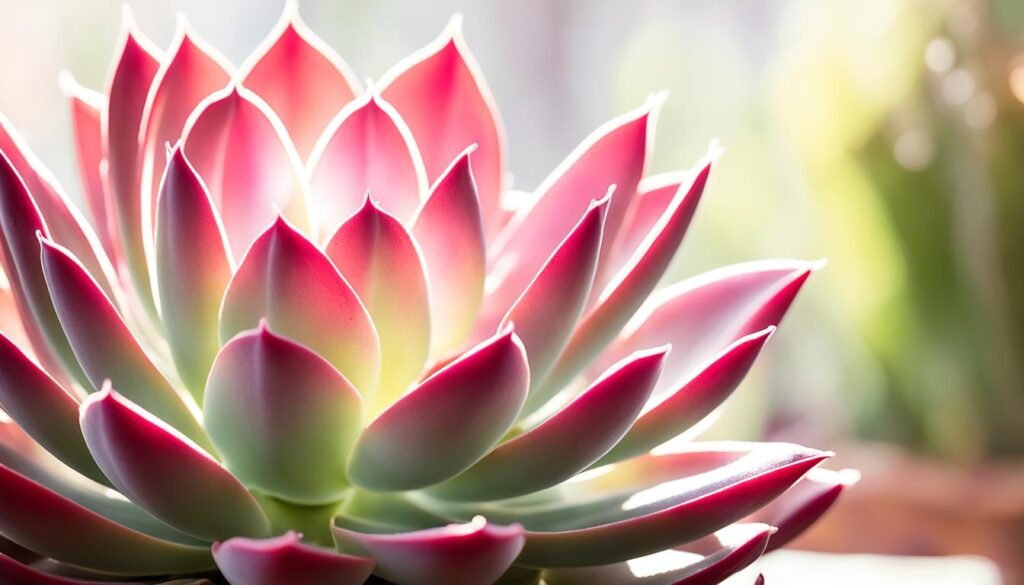
Why is Light Important for Echeveria Persia?
Light is crucial for the photosynthesis process in plants, including Echeveria Persia. Photosynthesis is the process by which plants convert light energy into chemical energy, allowing them to grow and thrive. Adequate sunlight exposure ensures that Echeveria Persia can produce the energy it needs to maintain vibrant foliage and support its overall health.
Tips for Providing Adequate Light
- Position your Echeveria Persia near a south-facing window to maximize light exposure.
- Ensure that the succulent receives at least 6-8 hours of bright, direct sunlight each day.
- Consider using artificial grow lights if natural light is limited in your space.
- Monitor the intensity of sunlight throughout the day to prevent scorching of the leaves.
- Rotate your Echeveria Persia periodically to promote even growth and prevent leaning towards the light source.
I have found that placing my Echeveria Persia near a sun-soaked window ledge has resulted in robust growth and vibrant foliage. It thrives in bright light, and the direct sunlight brings out its beautiful colors. Just be mindful of the intensity of sunlight during the peak hours of the day to prevent any leaf damage.
Nutrient Needs of Echeveria Persia
Echeveria Persia, like other succulent plants, has relatively low nutrient needs. Most potting soils already contain ample nutrients to support the plant’s growth. However, it is still important to replenish the nutrients in the soil periodically to ensure the long-term health and vibrancy of your Echeveria Persia.
One way to meet the nutrient needs of your Echeveria Persia is to repot the plant after it doubles in size or once a year. This will provide fresh soil with renewed nutrients to support its growth. When repotting, make sure to use a well-draining potting mix that includes materials like perlite or vermiculite. These additives improve the soil’s drainage, preventing moisture-related issues like root rot.
Alternatively, you can enhance the drainage properties of store-bought cactus soil by adding a few handfuls of perlite. This helps create a more suitable environment for your Echeveria Persia, allowing excess water to flow freely and avoid waterlogged conditions that can harm the plant.
To summarize, while Echeveria Persia does not have high nutrient requirements, it is still crucial to repot the plant periodically and use a well-draining potting mix to maintain its overall health and well-being.
“Proper soil and drainage are key to meeting the nutrient needs of Echeveria Persia, ensuring a vibrant and thriving succulent.”
| Nutrient Needs of Echeveria Persia | Instructions |
|---|---|
| Repotting | Repot the plant after it doubles in size or once a year to replenish nutrients. |
| Potting Mix | Use a well-draining potting mix that includes perlite or vermiculite for proper drainage. |
| Enhanced Drainage | Add a few handfuls of perlite to store-bought cactus soil to enhance its drainage properties. |
Temperature and Humidity for Echeveria Persia
The temperature and humidity levels play a crucial role in the health and growth of Echeveria Persia. As a succulent plant, it has specific requirements to thrive in a suitable environment.
Echeveria Persia thrives in temperatures between 70°F and 80°F. It is important to avoid exposing this succulent to temperatures below 40°F, as it cannot tolerate freezing conditions. Extreme cold can cause damage to the plant’s leaves and overall health.
Humidity is another factor to consider when caring for Echeveria Persia. This succulent enjoys high levels of humidity, which can be achieved through regular and thorough watering. By watering the plant deeply, the roots receive the necessary moisture and provide humidity to the plant. Placing the Echeveria Persia next to a humidifier can also help create an optimal environment for its growth.
By maintaining the appropriate temperature and humidity levels, you can ensure that your Echeveria Persia thrives and remains healthy, displaying its vibrant foliage.
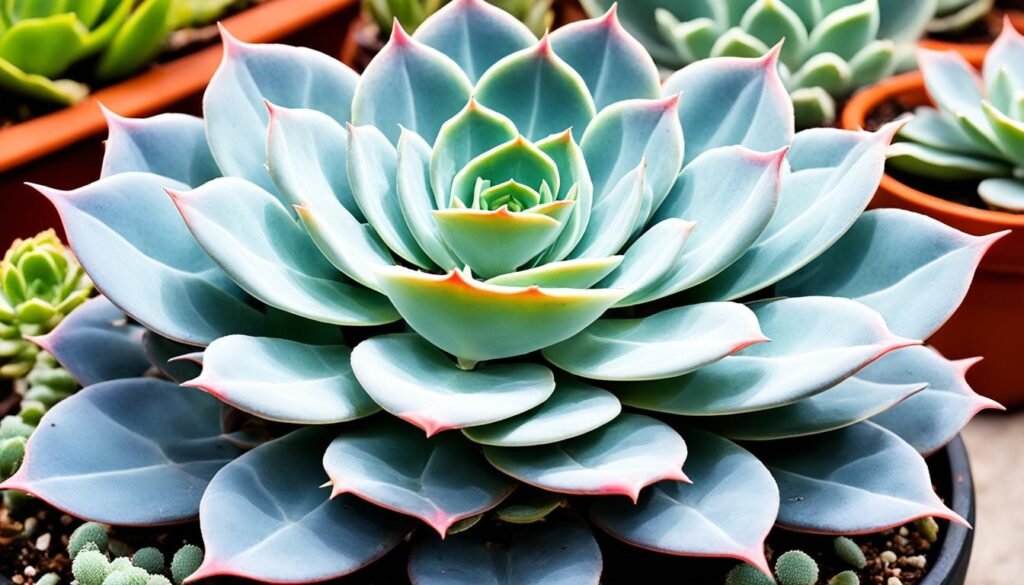
| Temperature | Humidity |
|---|---|
| 70°F – 80°F | High humidity levels |
| Avoid below 40°F | Water regularly and thoroughly |
Soil Requirements for Echeveria Persia
Echeveria Persia, a stunning succulent plant, requires specific soil conditions to thrive and maintain its vibrant foliage. Choosing the right potting mix is crucial to ensure the health and well-being of your Echeveria Persia. Here are the essential soil requirements to consider:
Well-Draining Potting Mix
Echeveria Persia is sensitive to wet soil, so it’s crucial to select a potting mix that provides excellent drainage. Opt for a mix that includes perlite or vermiculite, which helps prevent excess moisture and promotes better airflow around the roots.
Cactus Soil Mix
A cactus soil mix is an excellent option for Echeveria Persia as it is specifically formulated to meet the needs of succulent plants. It typically consists of a combination of well-draining materials such as sand, perlite, and peat moss. Mixing cactus soil with regular potting mix can also provide a suitable growing medium for your Echeveria Persia.
Avoid Water Retention
To prevent root rot and ensure healthy growth, it’s essential that the soil does not retain excessive moisture. Echeveria Persia thrives in dry conditions, so be cautious about overwatering. Choose a potting mix that allows water to flow freely through the soil, preventing waterlogged conditions that can harm the plant.
Organic Matter for Nutrition
While Echeveria Persia does not have high nutrient requirements, the addition of organic matter to the potting mix can provide some nutrition. Organic matter, such as well-rotted compost or coconut coir, can enhance the soil’s fertility and provide a source of slow-release nutrients for the succulent.
| Soil Requirements for Echeveria Persia | |
|---|---|
| Well-draining potting mix | Includes perlite or vermiculite |
| Cactus soil mix | Combines well-draining materials |
| Prevent water retention | Avoid overwatering and promote airflow |
| Organic matter for nutrition | Enhances soil fertility and nutrient content |
By selecting a suitable potting mix that meets the soil requirements of Echeveria Persia, you can create a favorable environment for your succulent’s growth and ensure its long-term health and vibrancy.
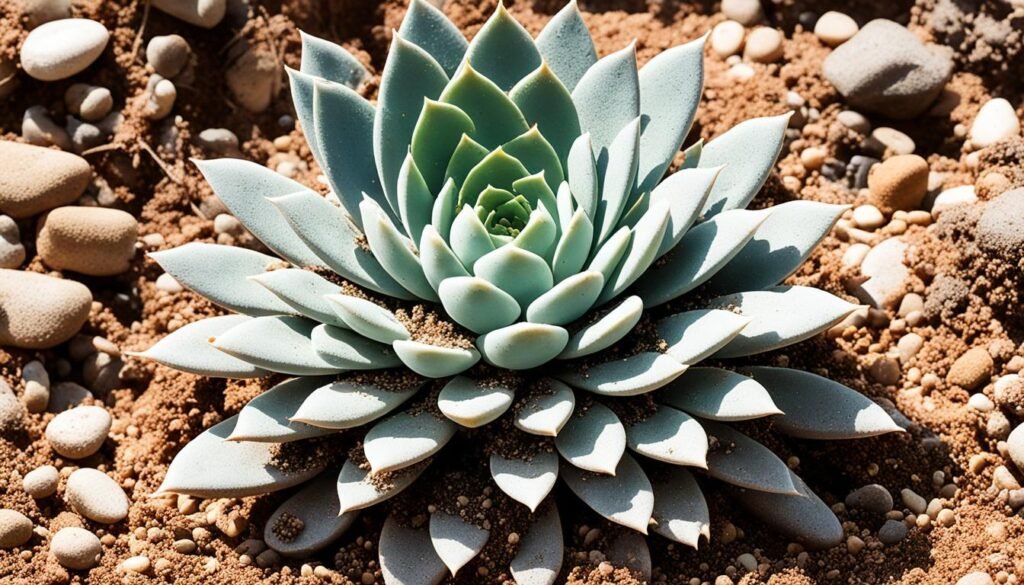
Propagation Techniques for Echeveria Persia
Echeveria Persia, like many succulent plants, can be propagated through various methods. This allows you to expand your collection or share the beauty of this succulent with others. There are two main propagation techniques for Echeveria Persia: leaf cuttings and offsets.
Leaf Cuttings
To propagate Echeveria Persia using leaf cuttings, carefully select mature leaves from the plant. Gently twist or cut the leaves, making sure to include the entire leaf blade and a small portion of the stem.
Prepare a well-draining soil mix for the leaf cuttings. A mix of cactus soil combined with perlite or vermiculite works well. This provides adequate drainage to prevent waterlogged soil.
Place the leaf cuttings on top of the soil mix, ensuring that the cut end of the leaf is in contact with the soil. Water lightly, taking care not to oversaturate the soil.
Provide indirect light for the leaf cuttings. Placing them near a bright window or under grow lights is ideal. Within a month, roots should start to form from the cut end of the leaf, and new growth will begin to emerge.
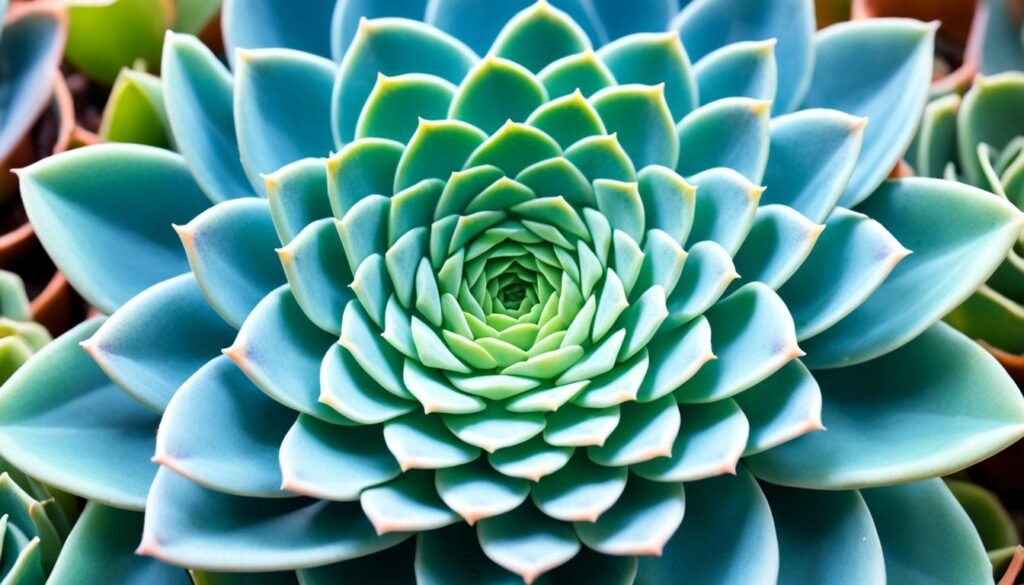
Offsets
Echeveria Persia produces offsets, also known as “pups,” around the base of the mother plant. These offsets can be carefully separated and propagated to grow new plants.
Wait until the offsets have grown to a reasonable size with their own set of roots and leaves. Gently remove them from the mother plant, taking care not to damage the roots or delicate leaves.
Prepare a well-draining soil mix, similar to the one used for leaf cuttings. Place the offsets on the soil mix and lightly water them. Provide indirect light to encourage their growth.
With proper care, the offsets will establish roots and develop into independent plants, mirroring the characteristics of the parent Echeveria Persia.
Note: It’s crucial to allow any cut or separated plant material to callus for a few days before planting them. This helps prevent rot and promotes successful propagation.
By utilizing these propagation techniques, you can propagate Echeveria Persia and continue to enjoy the beauty of this succulent in various locations within your home or share it with fellow succulent enthusiasts.
Dormancy and Growth Cycle
Echeveria Persia, like many succulent plants, goes through a dormant period during the winter months. This natural state is characterized by slower growth and the drying of lower leaves. Understanding the dormancy and growth cycle of your Echeveria Persia is crucial to its overall health and vitality.
During the dormant period, it’s important to adjust your watering schedule to avoid overwatering. Since the plant’s growth is minimal during this time, the soil will take longer to dry out. Make sure to space out your waterings, allowing the soil to dry completely in between.
In the spring, as the days lengthen and temperatures rise, your Echeveria Persia will enter its active growth phase. This is when you should resume regular watering and provide ample sunlight. The increased light and warmth will stimulate new growth and rejuvenate the plant.
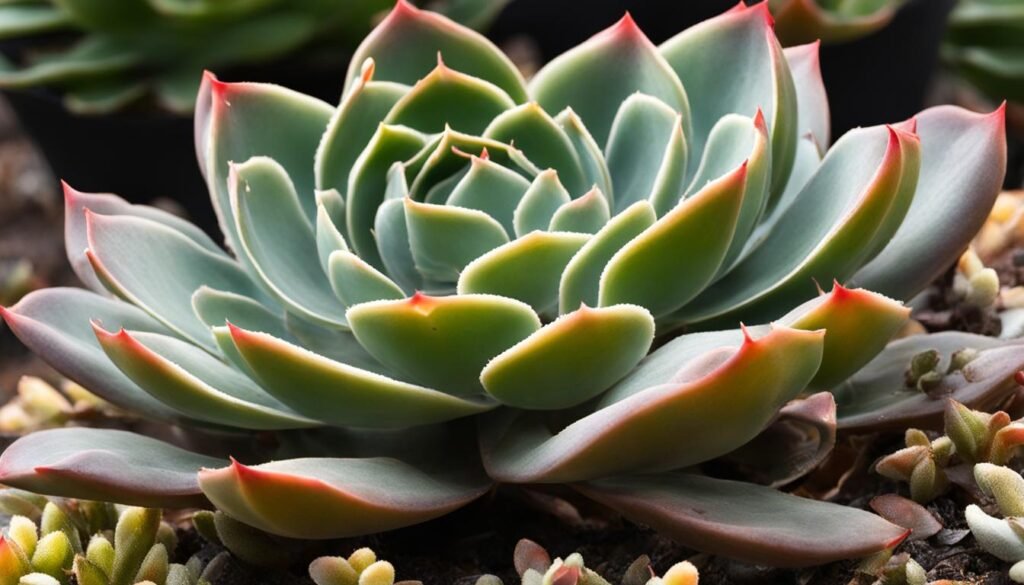
| Dormancy Period | Growth Phase |
|---|---|
| Winter months | Spring |
| Slower growth | Active growth |
| Drying of lower leaves | Rejuvenation |
| Watering spaced out | Regular watering |
The dormancy and growth cycle of Echeveria Persia is a natural process that mimics its native environment. By understanding and accommodating these cycles, you can ensure the long-term health and vibrancy of your succulent.
Troubleshooting Common Issues with Echeveria Persia
If you notice any signs of distress in your Echeveria Persia, such as yellowing, browning, or drooping leaves, it may indicate overwatering or nutrient deficiencies. To troubleshoot and address these common issues, follow these care tips:
- Check Soil Moisture: Ensure that the soil is neither too dry nor too wet. Overwatering can lead to root rot, while underwatering can cause the plant to dehydrate and show signs of stress.
- Assess Light Exposure: Echeveria Persia requires a balance of light. Too much direct sunlight can scorch the leaves, resulting in discoloration and damage. On the other hand, insufficient light can cause the plant to stretch or lose its vibrant colors. Adjust the position of your succulent to provide optimal light conditions.
- Consider Environmental Factors: Temperature and humidity can impact the health of your Echeveria Persia. Extreme temperatures, frost, or freezing conditions can harm the plant, while insufficient humidity can result in drying out. Be mindful of the environment and make necessary adjustments to ensure the succulent’s well-being.
Remember to observe and evaluate the overall conditions in which your Echeveria Persia is growing. Identifying and resolving common issues promptly will help your plant thrive and maintain its vibrant appearance.
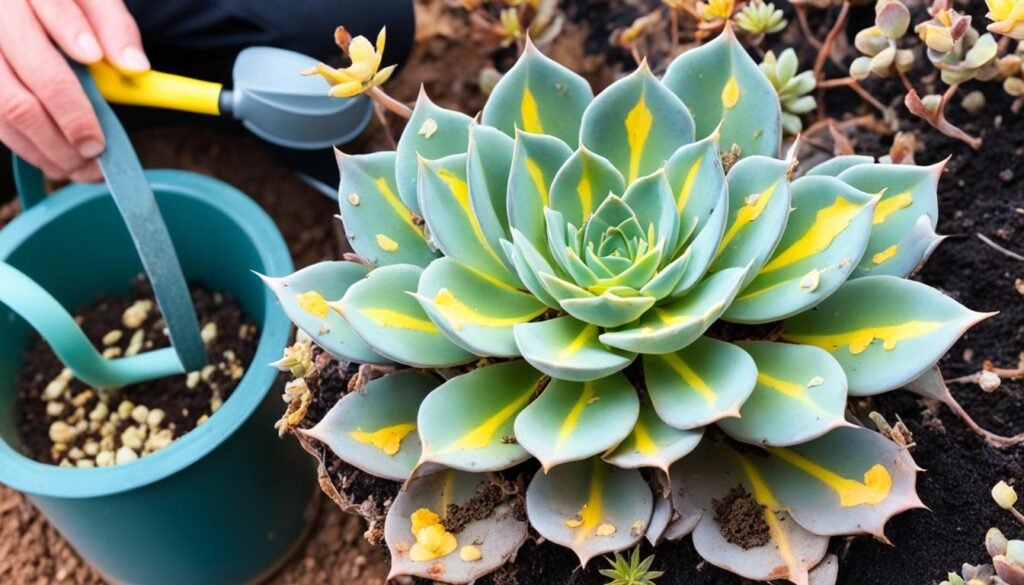
| Issue | Cause | Solution |
|---|---|---|
| Yellowing Leaves | Overwatering | Adjust watering frequency and ensure proper soil drainage. |
| Browning Leaves | Nutrient deficiencies | Consider using a balanced fertilizer or repotting with fresh potting mix. |
| Drooping Leaves | Overwatering or underwatering | Check soil moisture and adjust watering accordingly. |
Native Region and Flowering
Echeveria Persia is native to Central and northern South America. This succulent plant thrives in the arid climates of regions such as Mexico, Guatemala, and Honduras. Its natural habitat provides the perfect conditions for its growth, including plenty of sunshine and well-drained soil.
While Echeveria Persia does produce flowers in the wild, it is important to note that flowering is not a common occurrence when kept as a houseplant. The plant’s primary focus is on foliage growth, with its attractive rosette-shaped leaves stealing the show. The leaves come in vibrant colors such as shades of green, blue, purple, and pink, adding a touch of beauty to any indoor garden.
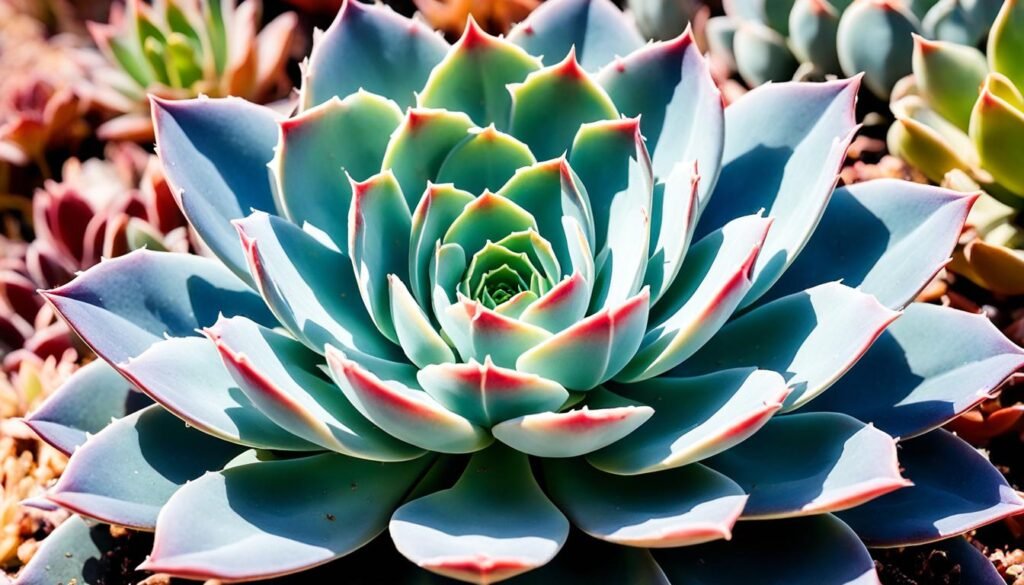
Where to Buy Echeveria Persia
Echeveria Persia, the stunning succulent plant, can be conveniently purchased from a variety of reliable sources. Whether you prefer to visit local garden centers and nurseries, explore online retailers, or participate in plant swaps, there are numerous options available to add this beautiful plant to your indoor garden.
When buying Echeveria Persia, it is essential to ensure that the plant is healthy and free from pests or signs of disease. Take your time to carefully examine the leaves and overall appearance before making a purchase. By selecting a healthy specimen, you can set the foundation for successful care and cultivation.
If you enjoy the convenience of online shopping, there are several reputable online retailers that specialize in succulent plants. These platforms offer a wide selection of Echeveria Persia and provide detailed information about each plant’s size, health, and care requirements. Additionally, online retailers often package and ship plants with utmost care, ensuring that they arrive in excellent condition.
Another option to acquire Echeveria Persia is through plant swaps, where fellow plant enthusiasts exchange plants with one another. Participating in plant swaps offers the opportunity to diversify your collection while connecting with other indoor gardening enthusiasts. It’s a wonderful way to share knowledge, experiences, and plants.
Lastly, if you already have one or more Echeveria Persia plants, you can propagate them to expand your collection. This method allows you to create new plants from existing ones by using offsets or leaf cuttings. By following proper propagation techniques, you can increase the number of Echeveria Persia plants in your indoor garden while saving money.
Where to Buy Echeveria Persia: Summary
In summary, you have multiple options when it comes to purchasing Echeveria Persia:
- Visit local garden centers and nurseries
- Explore online retailers specializing in succulent plants
- Participate in plant swaps with fellow enthusiasts
- Propagate from existing Echeveria Persia plants
Choose the method that best suits your preferences and needs. Whichever approach you decide on, remember to select healthy plants and enjoy the rewarding experience of adding Echeveria Persia to your indoor garden.
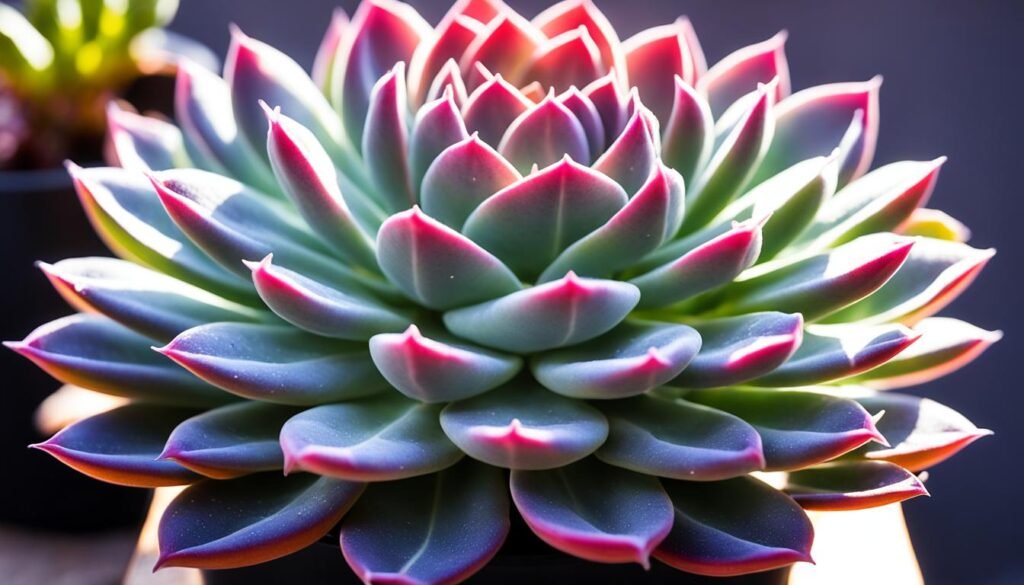
| Pros | Cons |
|---|---|
| Convenient access to a wide selection of Echeveria Persia plants | Physical stores may have limited stock |
| Online retailers provide detailed information about each plant | Shipping costs and delays may apply |
| Plant swaps allow for exchange and diversity among enthusiasts | Availability of Echeveria Persia may depend on local swaps |
| Propagation from existing plants is a cost-effective option | Propagation requires patience and time for new plants to mature |
Conclusion
With the right care and attention, your Echeveria Persia succulent plant can thrive and provide you with years of enjoyment. By following the care tips outlined in this indoor gardening guide, you can ensure the health and vibrancy of your Echeveria Persia.
Proper watering and light exposure are crucial for the well-being of your succulent. Remember to water sparingly, allowing the soil to dry out between watering sessions. Place your Echeveria Persia near a south-facing window to provide it with the bright and direct sunlight it needs to thrive.
In addition to watering and light requirements, it’s important to replenish the nutrients in the soil. Repot your succulent annually or when it doubles in size, using a well-draining potting mix that includes perlite or vermiculite. This will ensure proper drainage and provide essential nutrients for your Echeveria Persia.
Finally, embrace the art of indoor gardening and enjoy watching your Echeveria Persia flourish. With these care tips and techniques, you’ll be able to maintain the health and beauty of your succulent for years to come.
